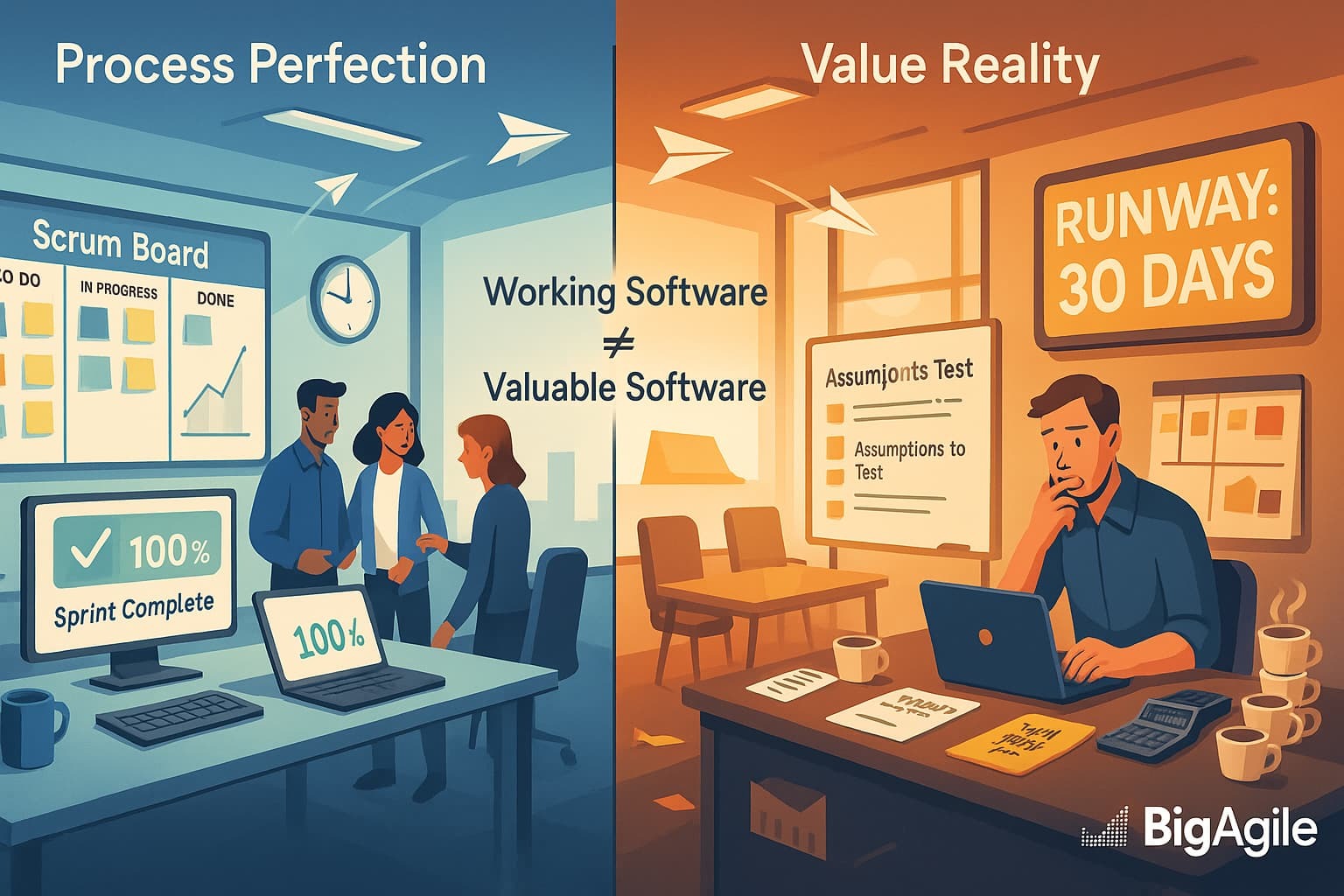
Not long ago, I witnessed a talented engineering team burn through $2 million in six months.
Their Velocity was impressive. Sprint after Sprint, they delivered working software. Their burndown charts looked great. Their retrospectives were insightful. By every Scrum metric, they were crushing it.
But they ran out of runway before finding product-market fit.
What Really Happened
Here’s the timeline:
Month 1: The Product Owner scheduled 23 demos with potential users who loved the concept. “This is exactly what we need!” they said. The team celebrated their validation.
Month 2: Procurement departments asked for ROI projections that the Product Owner couldn’t provide. The team kept building features.
Month 3: IT departments wanted integration specifications that didn’t exist yet. The team focused on their Sprint Goals.
Month 4: Finance teams needed justification for adopting “experimental” technology. The Product Backlog grew longer.
Month 5: End users pushed back because workflows weren’t designed with their input. The team ran more retrospectives to improve their process.
Month 6: Cash ran out during a “promising” pilot negotiation. Perfect Sprints. Zero revenue.
The Lesson That Changes Everything
Agile isn’t about delivering software faster. It’s about learning faster.
This team had mastered Scrum mechanics but missed the fundamental principle: empiricism. They were inspecting and adapting their process every Sprint, but they weren’t truly inspecting and adapting their product assumptions.
What Empiricism Really Means
Scrum is founded on empiricism, the idea that knowledge is derived from experience and that decisions are made based on what is observed. But here’s what many teams miss: empiricism isn’t just about your Sprint. It’s about your market, your users, and your business model.
The Scrum Guide tells us to “inspect the results and adjust for the next Sprint.” That doesn’t just mean “did we finish our Sprint Backlog?” It means “did we validate our assumptions about value?”
Three Pivots That Could Have Saved Them
1. Reframe the Product Vision
Instead of: “We’ll build AI that predicts outcomes with 94% accuracy.”
Try: “We’ll reduce readmission costs by $400K annually, guaranteed, with 90-day implementation.”
See the difference? One is about output (features and technology). The other is about outcomes (specific financial impact with accountability).
2. Build Smaller Increments of Value
The team was delivering working software every Sprint, which is good. But they weren’t delivering testable business value every Sprint, which is critical.
Each Sprint Goal should have answered a specific question:
- Sprint 1: “Will hospitals pay for a pilot?”
- Sprint 2: “Can we integrate with their existing systems in days, not months?”
- Sprint 3: “Will department heads champion this internally?”
- Sprint 4: “Does the ROI calculation convince procurement?”
Instead, they built a complete product, hoping all the assumptions were correct.
3. Pivot the Product Owner’s Focus
The Product Owner was excellent at managing the backlog, prioritizing features, and accepting work. But the role requires more. A Product Owner must be accountable for business outcomes, not just team output (don’t be a backlog manager).
Two questions every Product Owner should answer confidently:
- “What specific dollar amount will we save our customer?”
- “What happens if we don’t deliver that result?”
If you can’t answer both, you’re not ready to scale. You are prepared to run more experiments.
The Agile Transformation Nobody Talks About
Most Agile transformations focus on teams: teaching Scrum ceremonies, improving velocity, and achieving “done” increments. That’s necessary but not sufficient.
The more complex transformation is in product management: moving from feature factories to value discovery engines. This means:
Treating your Product Backlog as a hypothesis list. Every item represents an assumption about what creates value. Which assumptions are you testing first?
Redefining “working software.” Working means it compiles and passes tests. Valuable means someone will pay for it, or it reduces costs. Don’t confuse the two.
Embracing smaller bets. Would you rather build one complete solution that might work, or test ten smaller experiments that reveal what actually works?
Getting comfortable with “no.” The team in this story heard “we love this” in demos but never heard “yes, here's the purchase order.” In Agile, “no” is cheaper than “maybe” stretched over six months.
What This Means for Your Team
If you’re a Scrum Master, ask your Product Owner: “How will we know if this Sprint created value beyond our team?” If the answer is about velocity or story points, dig deeper.
If you’re a Product Owner, ask yourself: “Am I managing a backlog of features or testing a series of business hypotheses?” There’s a profound difference.
If you’re a team member, ask during Sprint Planning: “What will we learn from this Sprint that changes our next Sprint?” If the answer is only about process improvement, you’re missing half the picture.
The Question That Matters
Here’s the litmus test for your next Sprint Planning:
“If we successfully deliver everything in this Sprint Backlog, and it turns out customers don't want it, what will we have learned?”
If the answer is “nothing,” you’re building the wrong thing, just really efficiently.
Moving Forward
Agile transformation isn’t complete when your teams run smooth Sprints. It’s when your organization treats every Sprint as an experiment, every release as a learning opportunity, and every piece of feedback as a course correction.
The beautiful irony? That struggling startup eventually got it right. They cut their runway to 90-day pilots, focused on one measurable outcome, and built only what was needed to prove their value proposition. They’re still around today, profitable and growing.
They didn’t need to improve their Scrum process. They needed to embrace its underlying principle: make decisions based on what you observe, not what you hope.
The Bottom Line: You can have perfect Sprints and still build the wrong product. Agile isn’t about delivery speed. It’s about learning speed. Measure that, and everything else falls into place.
What assumptions are you testing in your next Sprint?